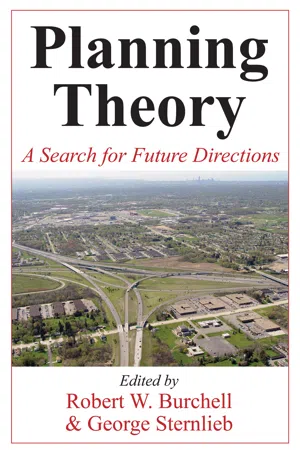
- 418 pages
- English
- ePUB (mobile friendly)
- Available on iOS & Android
About This Book
Theory and practice in city planning have never been known for their compatibility. The planner, dealing with stresses such as the personalities at work in a board meeting and coping with the realities of fund raising, political realities, and the like, can find little guidance in the theory of the trade. The issues of poverty groups, whether rural or urban, the provision of services, and the packaging of them are seemingly insuperable. The sheer frustration in the inability to deliver, which so many planners feel, can result in considerable impatience and a questioning of the relevance of theory.The editors argue that this state of affairs, though understandable, is unacceptable. While short-range meliorismwithout sense of perspective may be good for the practitioner's individual psyche, the cost may be borne by the long-run best interests of the groups to be served. The risks of a lack of perspective and the experiences generated by this phenomenon are too serious in their implications to permit the process to continue.In this new age of anxiety it is essential for both planners and theorists to understand their roles as well as provide guidance in shaping them. Burchell and Sternlieb have thus gathered here a variety of individuals, all of whom in their separate and distinct fashions are seasoned, both in practice and in theory. The book is divided into five sections: Physical Planning in Change, Social Planning in Change, Public Policy Planning in Change, Economic Planning in Change, and a final section detailing the roles of planners and who they are. These shared puzzlements and insights will prove useful to all practitioners and theorists in the planning field.
Frequently asked questions
Information
Practical Demand for Analytic Methods
Introduction
Date of | Units | Number | Variables | |
Survey/Analyst | Survey | Surveyed | of Units | Treated |
1. Adams | 1953 | Schools | 21 | Training offered |
2. Adams | 1953 | Agencies | 35 | Training needs |
3. Krueckeberg | 1963 | Agencies | 109 | Planning activities |
4. Hemmens | 1967 | Agencies | 26 | Model usage |
5. Cobb and Sweet | 1969 | Agencies | 91 | Model usage |
6. ICMA | 1970 | Cities | 844 | ADP usage |
7. Harman | 1971 | Agencies | 954 | Planning activities |
8. Schon, et al. | 1960-71 | Planners | 90 | Skills used |
9. ACIR | 1972 | Agencies | 289 | COG activities |
10. Gerecke | 1972 | Agencies | 52 | Canadian planning |
11. Jefferson | 1972 | Agencies | 108 | Methods: England and Wales |
12. Thorwood | 1972 | Cities | 268 | Planning and management |
13. Kaufman | 1973 | Planners | 5500 | Specializations |
14. Pack | 1973 | Agencies | 782 | Model usage |
15. ALP. | 1972-74 | Planners | 476 | Specializations |
16. Isserman | 1973-74 | Schools | 41 | Methods taught |
17. Isserman | 1974 | Planners | 84 | Methods used |
18. Susskind | 1974 | Schools | 63 | Graduate programs |
19. Pack and Pack | 1975 | Agencies | 30 | Model usage |
20. Logan | 1975 | Schools | 38 | Social planning courses |
Table of contents
- Cover Page
- Title Page
- Copyright Page
- Contents
- PREFACE
- INTRODUCTION: PLANNING THEORY IN THE 1980s–A SEARCH FOR FUTURE DIRECTIONS
- SECTION I: PHYSICAL PLANNING IN CHANGE-THE ROLE OF ENVIRONMENTAL PLANNING
- The Role of the Physical Urban Planner
- Ecological Planning: The Planner As Catalyst
- Planners as Architects of Built Environment—or Vice Versa
- Make No Big Plans . . . Planning in Cleveland in the 1970s
- SECTION II: SOCIAL PLANNING IN CHANGE-PRACTICAL APPLICATIONS OF SOCIAL SENSITIVITY
- Social Planning and Social Science: Historical Continuities and Comparative Discontinuities
- The Redistributive Function in Planning: Creating Greater Equity Among Citizens of Communities
- Social Planning and the Political Planner
- Politics, Planning, and Categories—Bridging the Gap
- Social Planning and the Mentally and Physically Handicapped: The Growing “Special Service” Populations
- SECTION III: PUBLIC POLICY PLANNING IN CHANGE-MACRO-PLANNING VERSUS LOCAL CONTROL
- Planning Behavior and Professional Policymaking Activity
- A Difference Paradigm for Planning
- Innovation, Flexible Response and Social Learning: A Problem in the Theory of Meta-Planning
- The Planner as Interventionist In Public Policy Issues
- Notes On An Expedition To Planland
- Planning—An Historical and Intellectual Perspective
- SECTION IV: ECONOMIC PLANNING IN CHANGE-NATIONAL PLANNING, DEMAND VERSUS SUPPLY EMPHASES
- On Planning the Ideology of Planning
- Planning In An Advanced Capitalist State
- The Comprehensive Planning of Location
- Economics in Urban Planning: Use, Skills and Supply
- SECTION V: WHAT ARE PLANNERS? WHAT DO PLANNERS DO? AND HOW ARE THEY PREPARED FOR THEIR TASKS?
- Three Crises of American Planning
- Seven Hills On the Way To the Mountain: The Role of Planning and Planners
- Practical Demand For Analytic Methods
- Planning Education: The Challenge and the Response
- BIBLIOGRAPHY